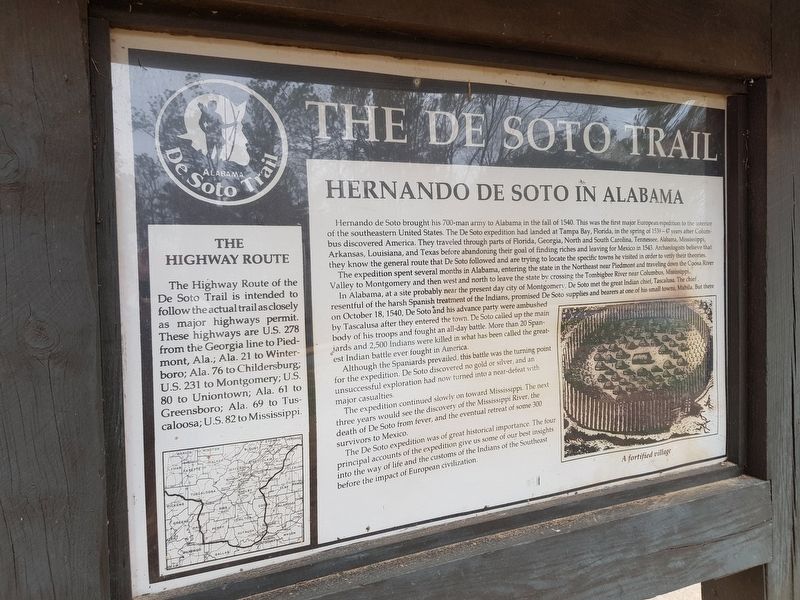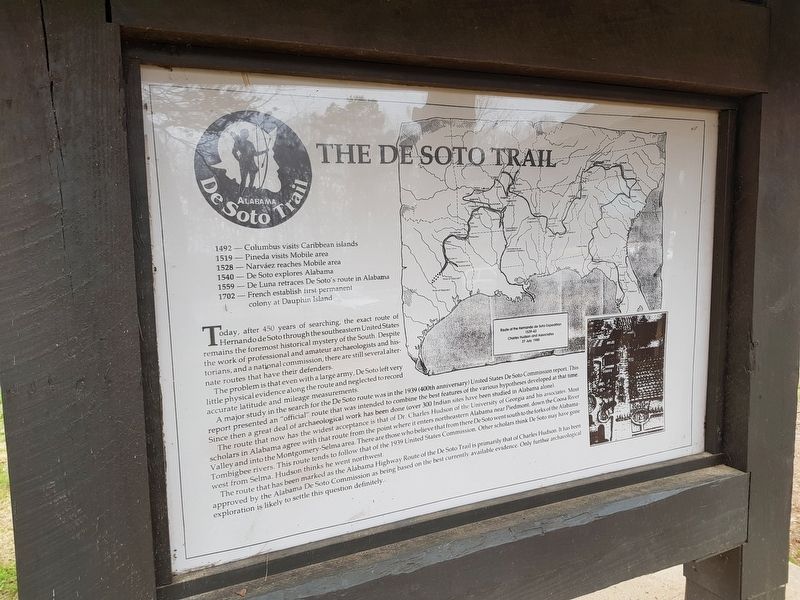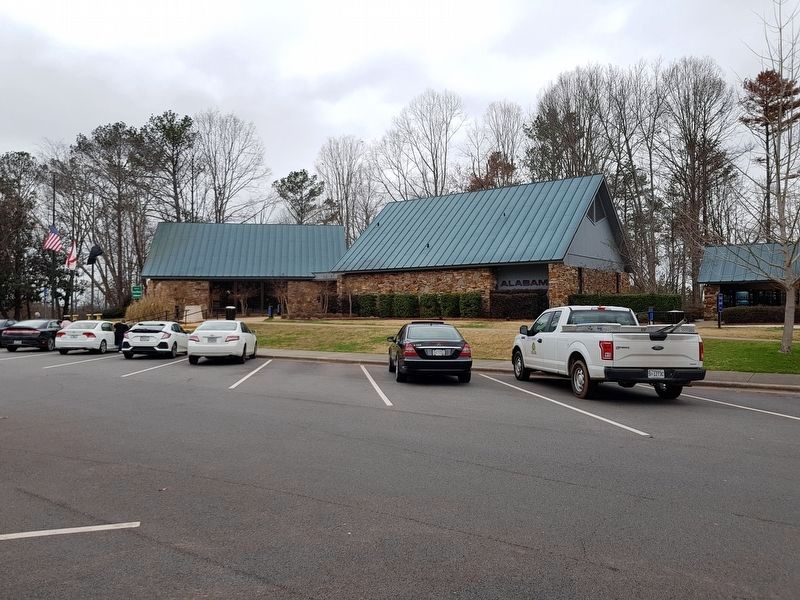Muscadine in Cleburne County, Alabama — The American South (East South Central)
Hernando de Soto in Alabama
The De Soto Trail
Hernando De Soto in Alabama
Hernando de Soto brought his 700-man army to Alabama in the fall of 1540. This was the first major European expedition to the interior of the southeastern United States. The De Soto expedition had landed at Tampa Bay, Florida, in the spring of 1539 -- 47 years after Columbus discovered America. They traveled through parts of Florida, Georgia, North and South Carolina, Tennessee, Alabama, Mississippi, Arkansas, Louisiana, and Texas before abandoning their goals of finding riches and leaving for Mexico in 1543. Archaeologists believe that they know the general route that De Soto followed and are trying to locate the specific towns he visited in order to verify their theories.
The expedition spent several months in Alabama, entering the state in the Northeast near Piedmont and traveling down the Coosa River Valley to Montgomery and then west and north to leave the state by crossing the Tombigbee River near Columbus, Mississippi.
In Alabama, at a site probably near the present day city of Montgomery, De Soto met the great Indian chief, Tascalusa. The chief, resentful of the harsh Spanish treatment of the Indians, promised De Soto supplies and bearers at one of his small towns, Mabila. But there on October 18, 1540, De Soto and his advance party were ambushed by Tascalusa after they entered the town. De Soto called up the main body of his troops and fought an all-day battle. More than 20 Spaniards and 2,500 Indians were killed in what has been called the greatest Indian battle ever fought in America.
Although the Spaniards prevailed, this battle was the turning point for the expedition. De Soto discovered no gold or silver, and an unsuccessful exploration had now turned into a near-defeat with major casualties.
The expedition continued slowly on toward Mississippi. The next three years would see the discovery of the Mississippi River, the death of De Soto from fever, and the eventual retreat of some 300 survivors to Mexico.
The De Soto expedition was of great historical importance. The four principal accounts of the expedition give us some of our best insights into the way of life and the customs of the Indians of the Southeast before the impact of European civilization.
Caption: A fortified village. The image is of ‘A fortified Indian village’, 1563, engraving by Theodore de Bry (1528 - 1598), from his “Brief Description of what happened in the French Province of Florida America”.
The Highway Route
The Highway Route of the De Soto Trail is intended to follow the actual trail as closely as major highways permit.
These highways are U.S. 278 from the Georgia line to Piedmont, Ala; Ala. 21 to Winterboro; Ala. 76 to Childersburg; U.S. 231 to Montgomery; U.S. 80 to Uniontown; Ala. 61 to Greensboro; Ala. 69 to Tuscaloosa; U.S. 82 to Mississippi.
Reverse:
The De Soto Trail
1492 - Columbus visits Caribbean islands
1519 - Pineda visits Mobile area
1528 - Narváez reaches Mobile area
1540 - De Soto explores Alabama
1559 - De Luna retraces De Soto's route in Alabama
1702 - French establish first permanent colony at Dauphin Island
Today, after 450 years of searching, the exact route of Hernando de Soto through the southeastern United States remains the foremost historical mystery of the South. Despite the work of professional amateur archaeologists and historians, and a national commission, there are still several alternate routes that have their defenders.
The problem is that even with a large army, De Soto left very little physical evidence along the route and neglected to record accurate latitude and mileage measurements.
A major study in the search for the De Soto route was in the 1939 (400th anniversary) United States De Soto Commission report. This report presented an "official" route that was intended to combine the best features of the various hypotheses developed at that time. Since then a great deal of archaeological work has been done
(over 300 Indian sites have been studied in Alabama alone).
The route that now has the widest acceptance is that of Dr. Charles Hudson of the University of Georgia and his associates. Most scholars in Alabama agree with that route from the point where it enters northeastern Alabama near Piedmont, down the Coosa River Valley and into the Montgomery-Selma area. There are those who believe that from there De Soto went south to the forks of the Alabama Tombigbee rivers. This route tends to follow that of the 1939 Unites States Commission. Other scholars think De Soto may have gone west from Selma. Hudson thinks he went northwest.
The route that has been marked as the Alabama Highway Route of the De Soto Trail is primarily that of Charles Hudson. It has been approved by the Alabama De Soto Commission as being based on the best currently available evidence. Only further archaeological exploration is likely to settle this question definitely.
Caption: Route of the Hernando de Soto Expedition 1539-43
Charles Hudson and Associates 27 July 1988
Image of the “Tovvne of Secota” by De Bry (printed 1590) based on a watercolor by White.
Erected by Alabama De Soto Trail.
Topics. This historical marker is listed in these topic lists: Colonial Era
• Exploration • Native Americans • Wars, Non-US. A significant historical date for this entry is July 27, 1988.
Location. 33° 40.154′ N, 85° 22.274′ W. Marker is in Muscadine, Alabama, in Cleburne County. Marker can be reached from Interstate 20 (Interstate 20) west of Alabama Route 37, on the right when traveling west. The marker is just south of the Cleburne Welcome Center near the parking and picnic area. Touch for map. Marker is in this post office area: Muscadine AL 36269, United States of America. Touch for directions.
Other nearby markers. At least 8 other markers are within 14 miles of this marker, measured as the crow flies. Historic Tallapoosa (approx. 7.1 miles away in Georgia); Seven Chestnuts (approx. 7.3 miles away in Georgia); Sandtown Trail (approx. 7.4 miles away in Georgia); Hungarian Colony (approx. 9.4 miles away in Georgia); Whatley Memorial Historic Park (approx. 11.1 miles away in Georgia); Site of Bowdon College (approx. 11.1 miles away in Georgia); Last Land in Georgia Ceded by the Creeks (approx. 11.4 miles away in Georgia); Haralson County (approx. 13.9 miles away in Georgia).
Credits. This page was last revised on February 24, 2018. It was originally submitted on February 24, 2018, by J. Makali Bruton of Accra, Ghana. This page has been viewed 1,762 times since then and 166 times this year. Photos: 1, 2, 3, 4. submitted on February 24, 2018, by J. Makali Bruton of Accra, Ghana.



